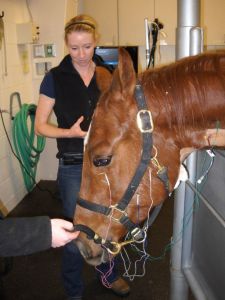By Stephanie Meyer, DVM, Pilchuck Veterinary Hospital
Biomechanics is the study of the structural, functional and mechanical aspects of motion. Structure determines movement. Individual structures, called motion units, are determined and limited by anatomy, including bones, ligaments, muscles and tendons. Bones define the fundamental structure of a motion unit; ligaments restrict the movement of these bones; muscles and tendons are what move the motion unit. The individual motion units studied in biomechanics can only move one way – the way they are constructed, requiring all elements to be healthy and strong and to function in harmony.
Chiropractic philosophy is based on the relationship between the musculoskeletal and nervous systems. Chiropractic focuses on the biomechanical dysfunction of the motion units of the spine and its effect on the entire nervous system. Animal chiropractors provide an additional means of diagnosis and treatment options, along with traditional veterinary care, to help your horse maintain optimal health and biomechanical movement.
Animal chiropractors treat vertebral subluxation complexes (VSCs), which are misalignments between two articular structures (spinal or extraspinal). Misalignment causes joint dysfunction that may directly or indirectly affect the biomechanical and/or neurophysiological actions of these joints, resulting in decreased or inappropriate mobility, stiffness, pain, and interrupted transfer of information between the central nervous system and the rest of the body. An animal with a VSC will change its posture to compensate; consequently, inappropriate biomechanical movement occurs. This compensation causes increased mechanical strain on other parts of the musculoskeletal system, leading to secondary restrictions and deterioration. Additionally, sensory information from the affected joint to the central nervous system is interrupted. The symptoms of these changes may be as subtle as a mild decrease in performance or as significant as complete mechanical dysfunction and lameness.
VSCs can be caused by many things, including physical, chemical and emotional stress. Therefore, any animal – young, developing animals, older animals with or without preexisting issues, backyard companions, elite athletes – can benefit from chiropractic care. Chiropractic adjustments are recommended to:
- Maintain soundness – prophylactic treatment to maintain joint health and appropriate biomechanical movement
- Enhance performance in the equine athlete
- Treat pain in the neck, back or limbs
- Enhance post-surgical healing or recovery from trauma
 The chiropractic adjustment is a very specific, high-speed, low-force, controlled thrust, which is directed at the affected articulation (i.e., vertebrae or joint). The adjustment moves the affected joint beyond its normal range of movement, without exceeding the anatomical barrier or integrity of the joint. The adjustment returns proper function and movement to the joint, as well as reestablishes appropriate communication (sensory and motor input) with the central nervous system.
The chiropractic adjustment is a very specific, high-speed, low-force, controlled thrust, which is directed at the affected articulation (i.e., vertebrae or joint). The adjustment moves the affected joint beyond its normal range of movement, without exceeding the anatomical barrier or integrity of the joint. The adjustment returns proper function and movement to the joint, as well as reestablishes appropriate communication (sensory and motor input) with the central nervous system.
The frequency of chiropractic adjustments is individual to each horse, and is determined by acute versus chronic problems, injury versus maintenance, and/or pre-existing medical or mechanical conditions.
Only veterinarians or chiropractors who have completed additional post-graduate training and have been certified in animal chiropractic are equipped with the necessary knowledge to accurately diagnose and treat your horse’s VSCs.
www.PilchuckVet.com/articles/equine-biomechanics-and-chiropractic



